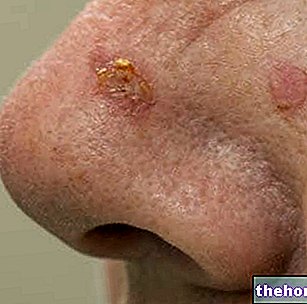What is the ichthyosis vulgaris
Ichthyosis vulgaris is the least severe form of hereditary genodermatoses. Together with lamellar ichthyosis, X-linked ichthyosis and epidermolytic hyperkeratosis, ichthyosis vulgaris is the most common form of this particular group of diseases. of the skin.

See More Photos Ichthyosis Vulgaris
Similarly to the other forms, ichthyosis vulgaris is characterized by the presence of dry skin and the formation of scales that make the appearance of the skin similar to that of fish skin (hence the term "ichthyosis").
Incidence
Ichthyosis vulgaris has a rather high incidence index which is estimated in one case every 250-1,000 individuals depending on the ethnic group.
This form of ichthyosis affects males and females of all ethnic groups indiscriminately, with an autosomal dominant transmission.
Causes
Ichthyosis vulgaris could be caused by an "alteration at the level of a gene (so the mutation is transmitted to the child by one of the parent carriers), or the disease could be the consequence of an" induced and spontaneous alteration of the affected subject. "last case, means that the person suffering from ichthyosis vulgaris represents the first case in the family and the pathology was not transmitted from the parents.
Research has not yet "identified the molecular mechanism underlying" ichthyosis vulgaris, but it is assumed that an alteration of filaggrin is the most plausible trigger. Filaggrin is a protein that constitutes the deep layer of the epidermis. implacable in the protection of the skin from external environmental factors and useful for keeping the hydration of the skin under control; it follows that the defect of filaggrin involves alterations in the hydration of the skin, consequently, ichthyosis.
In detail, it is the FLG gene (which codes, in fact, for filaggrin) that is altered and transmitted from parents to children. The gene can have one or more mutations that lead to an "inevitable altered formation of the epidermal layer. More precisely, there is an" alteration in the cohesion of the keratinocytes, which results in the formation of scales.
The severity of ichthyosis vulgaris usually depends on the number and type of genetic mutations.
Symptoms
Ichthyosis vulgaris generally does not present itself at birth: it is a subtle disease that takes a few years to evolve and manifest symptoms.
In truth, to be precise, ichthyosis vulgaris can appear shortly after birth, but - more often than not - it is simply confused with "dry skin" and, therefore, it is not considered necessary to carry out more detailed investigations or proceed with particular treatments. .
In general, a clearer symptom picture is diagnosed around the first year of life with a diffuse cutaneous xerosis: the skin has small whitish scales (caused by the altered cohesion of the keratinocytes), particularly in the legs and arms.
In most people with ichthyosis vulgaris, the face, palms of the hands, soles of the feet, knees, armpits and the "groin (" crease areas ") are not affected. This is because these areas are generally" more humid "than the other areas of the body that, on the other hand, are affected.
However, there are cases of people suffering from ichthyosis vulgaris in which the forehead, cheeks and palms take on a different consistency from the normal one, presenting an abnormal thickening.
Itching is a condition that often occurs in people affected by ichthyosis vulgaris, caused mainly by dryness of the skin, by the presence of micro-cracks and roughness of the skin. It is clear that, since ichthyosis vulgaris is an epidermal manifestation, the organs interiors are unharmed.
These symptoms tend to worsen slightly in winter and in arid climate areas: in summer, most people suffering from ichthyosis vulgaris record a marked improvement in the disease, the manifestations of which are so reduced as to be almost imperceptible. Indeed, in adulthood, ichthyosis can regress in the presence of a hot-humid climate and then reappear in old age.
Associated pathologies
Ichthyosis vulgaris is often associated with atopy (tendency to manifest allergy following ingestion or contact with allergens) and, sometimes, follicular keratosis.
Among the associated pathologies, eczema is also mentioned (especially of the hands), found in half of the affected subjects.
Furthermore, individuals with ichthyosis vulgaris are particularly susceptible to the development of pathologies, such as asthma and allergic rhinitis.
Care
Also in this type of ichthyosis - given the causes of genetic origin - a cure able to definitively cure the disorder has not yet been developed.
However, there are treatments (usually topical) that can alleviate the discomforts deriving from ichthyosis vulgaris.
Subject to medical advice, it would be good to apply emollient and keratolytic substances directly on the skin (which promote desquamation, consequently cell renewal):
Salicylic acid, urea, glycolic acid, ammonium lactate, retinoic acid are the most used substances for keratolytic purposes. However, these active ingredients and the preparations containing them must be used only if prescribed by the dermatologist and only under his strict control. in particular, the use of retinoids requires particular attention, as they can cause various side effects, some of which are even serious.
Vaseline, propylene glycol, lanolin, on the other hand, represent the emollient substances most used in topical preparations.
The use of products containing the aforementioned ingredients must be frequent and constant; if this were not the case, the effect of the treatment would be practically in vain.
Considering that many formulations against ichthyosis vulgaris are characterized by salicylic acid and derivatives, their use in children is not recommended to avoid manifestations of salicilism, a disorder that causes dizziness, nausea and vomiting.
Systemic retinoids, shock therapy already analyzed in Harlequin ichthyosis, are also useful in the most acute and severe forms of ichthyosis vulgaris; the problem of oral retinoids is that they involve many side effects (dry mouth, dry mucous membranes , xerophthalmia and alterations of cholesterol and triglycerides), sometimes more serious than the manifestations derived from "ichthyosis vulgaris itself.
Summary
To fix the concepts ...




























